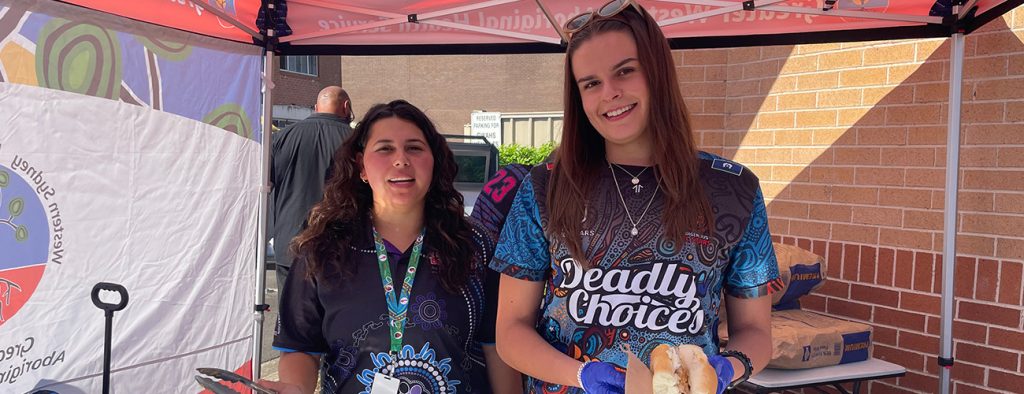
A new Australian Institute of Health & Welfare report highlights that regular primary care visits help First Nations people stay healthier, reduce hospital stays, and lower early death rates.
Yet, in Western Sydney, disparities persist. There is still a significant gap in usage of primary health checks like the MBS 715 health check between local government areas (ii). In 2023-2024, just 9.8 percent of First Nations people living in the Hills Share used the 715 health check compared to 27.5 percent of 715 usage in Blacktown LGA.
The Western Sydney Primary Health Network (WSPHN) Needs Assessment 2025-2028 highlights significant gaps in health for First Nations people living in Western Sydney.
The report found higher numbers of First Nations residents receiving disability support also experienced asthma, arthritis, diabetes and a mental health condition.
The Needs Assessment also highlighted a drop-in full immunisation rate for First Nations two-year-old children from 91.3% to 88.1% between 2020 and 2022 compared to stable rates among non-indigenous two-year-olds (91.4% and 90.85% between 2020 and 2022).
WSPHN Chief Executive, Andrew Newton said Closing The Gap Day was an important moment to strive harder for the First Nations people of Western Sydney.
“Closing The Gap Day isn’t just about statistics. For the First Nations people of Western Sydney, we can make a difference to improve health across the lifespan and ultimately improve the lifespan,” Mr Newton said.
“It’s been 20 years since the release of the Social Justice Report which started Close The Gap and for 10 years Primary Health Networks have been focused on this goal.
“The Western Sydney Primary Health Network Needs Assessment tells us a story that we need to do better.
“We know that childhood immunisation is vital and we know that regular primary health care at all ages can reduce the burden of chronic disease for First Nations people.
“WentWest is committed to Closing The Gap by working with GPs, commissioned providers and other health care professionals.
“Using the findings from our latest Needs Assessment, we’re currently developing strategies to address the inequities that exist for First Nations people in Western Sydney.”
Key Findings in the AIHW Report
Life Expectancy – Australia has one of the highest life expectancies in the world but is 8.8 years lower for First Nations men and 8.1 years lower for First Nations women. Regular primary care, including 715 health checks, has been associated with greater reductions in hospitalisations and deaths. The report recommends increasing health literacy and self-management of chronic disease, providing links to services within and outside the health system and improving screening and treatment of acute and chronic illnesses.1
Child Health – The percentage of First Nations babies born with low birth weight was twice as high as among non-Indigenous babies. Antenatal care and reduction in smoking rates while pregnant have been suggested as key strategies for improvement.
Suicide – the age-standardised rate of suicide deaths for First Nations people increased from 19 to 30 per 100,000 in the decade from 2012 to 2022. The report recommended multidimensional First Nations-led responses including services outside the health sector, such as housing, education, employment, recreation, child protection and family services, crime prevention and justice.
Key Findings from the Western Sydney Needs Assessment
Summary of key health needs for First Nations people in the region 2021-20241.
Three-quarters of First Nations residents receiving financial support for disability and experiencing a chronic condition resided in Blacktown LGA (74.5%).
Asthma, arthritis, diabetes and a mental health condition were the most reported chronic conditions among these.
Usage of MBS 715 health check ranged from a low of 9.8% in the Hills Shire LGA to a high of 27.5% in Blacktown LGA.
The potential need for aged care was lower among First Nations residents aged 50 years and over (166.8 per 1,000 people) than residents in the wider community (273.4 per 1,000 people).
There was a steady increase in uptake of WSPHN-commissioned alcohol and other drug services by First Nations residents (179 to 286 patients between 2022-23 and 2023-24).
Caring for First Nations Patients in Western Sydney
Primary care practices are encouraged to work with local First Nations providers to improve care for their patients. These services are commissioned by Western Sydney Primary Health Network.
- Western Sydney Integrated Team Care (ITC) offers chronic disease care coordination and support
- Baabayn Corporation helps clients heal from trauma, develop self-esteem and reconnect to their community
- Marrin Weejali Aboriginal Corporation provides culturally safe alcohol and other drugs (AOD), and non-acute mental health counselling, referral, and advocacy services
- The Shed offers wellbeing activities, social service navigation, and coordination linking clients to housing, legal, family and child, and AOD services
- Too Deadly for Diabetes is a ten-week program supporting those with, or at risk of, type 2 diabetes. Patients can be referred through Marrin Weejali
- The Burbaga Burawa health challenge encourages healthy eating and lifestyle change
- Aboriginal Counselling Services deliver intervention services to Aboriginal people in a sensitive way and appropriate based on the individual’s circumstances
- Aboriginal and Torres Strait Islander Monday Clinic specifically for those who identify as Aboriginal and/or Torres Strait Islander with Type 1 and complex Type 2 Diabetes at Mt Druitt Community Health Centre’s Diabetes Clinic.
The Mount Druitt Diabetes Clinic is a partnership between Blacktown Hospital and the Western Sydney Diabetes (WSD) team and helps manage people living with Type 1 and complex Type 2 diabetes in Mount Druitt and Blacktown.
(i) Closing the Gap targets: key findings and implications, Long and healthy lives – Australian Institute of Health and Welfare – March 2025
(ii) Western Sydney Primary Health Network Needs Assessment 2025-2028
Information is correct as of 20 March 2025.